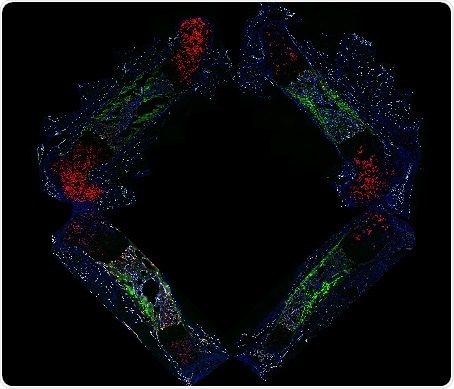Jun 27 2018
Maintaining equal growth rates in opposing limbs is crucial for animals to achieve a symmetrical adult form; what happens if something goes wrong with one limb during development? According to a study publishing June 26 in the open access journal PLOS Biology by Alberto Roselló-Díez, Alexandra Joyner, and colleagues of the Sloan Kettering Institute in New York, mice can stimulate local growth while suppressing overall growth, thereby allowing damaged tissues to catch-up with other tissues, and making sure that bones in opposite limbs lengthen together when one is injured.

Sections of right and left hindlimb skeletal elements (femora and tibiae) from ePit-Col-p21 embryos expressing p21 preferentially in the left cartilage (right side of image). Red= tdTomato, Green= calcein, White= CD31 staining, Blue= DAPI. Femur and tibia from each side were relocated, rotated and stitched together digitally. Image Credit: Alberto Roselló-Díez
It is already known that after local injury, insects accomplish this by combining compensatory proliferation in the injured body part and growth delay in other parts of the body, but in vertebrates the corresponding responses have not been clear.
To explore how coordinated growth is achieved in vertebrates, the authors engineered mice to express a cell cycle suppressor, shortly before birth, specifically in bone-forming cartilage cells in one hind limb, but not the other; this allowed them to inhibit bone growth on one side while maintaining normal growth on the other side. On the inhibited side, they further limited the expression of the suppressor to only some of the bone-forming cells, allowing them to examine the responses of unsuppressed cells on the same side.
They found that, within the targeted cartilage, those cells not producing the cell-cycle suppressor proliferated more than normal, so that overall growth on the affected side was only mildly slowed. The signal that drove this hyperproliferation is not yet clear, but the authors found that, once a certain injury threshold was surpassed, the response was proportional to the number of cells that had been suppressed. They further found that, in response to the local slowing of growth, there was a systemic reduction in rate of growth that correlated with an impairment of insulin-like growth factor signaling in the placenta, which, the authors suggest, likely acts as a central regulator of overall growth rate and body proportions during development.
Noting the similarities between growth regulation mechanisms between insects and vertebrates, the authors said:
These results reveal that the response to developmental insults is quite evolutionarily conserved, and open new avenues of future research and to develop therapies for growth disorders.”